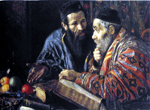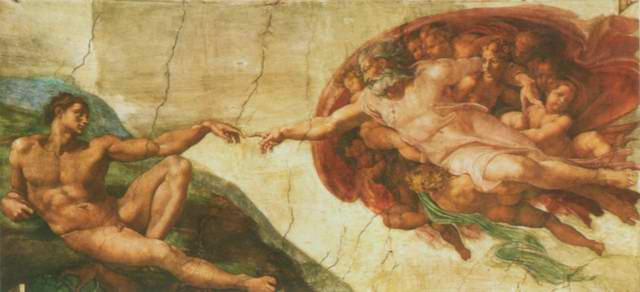


“A zaddik asks one of his disciples, ‘If a Jew arises from his bed in the morning and has to choose in one moment between two ways, the love of God and the love of neighbor, which takes precedence over the other?’ The disciple did not know. Then he explained: ‘In the prayer book it is stated, ‘Before praying one shall say the verse: Love thy fellow as one like thyself!’ The true love of God begins with the love of men. And if one should say to you that he has love for God and has no love for men, know that he lies.’” (Buber, p. 229)
Commentary
The lesson of this Hasidic story is that one cannot truly love God unless he first loves his fellow man. The pietist who isolates himself in relation to the world and professes to love God and God alone is both self-deluded and selfish. In withdrawing from the difficulties of building and maintaining relationships with his fellow human beings, he precludes the possibility of coming to know the God of the world Who has put up His tent in all of mankind. The worship of God in isolation therefore leads only to a partial knowledge of God – the God of one’s personal soul. It also withholds from (Buber says “steals from”) one’s fellow human beings that which is their due – the nourishment and love they would receive from a person who lives fully in the world. The only way to know God in His wholeness is to approach Him from both directions simultaneously – by loving one’s fellow man (in whom resides a particle of God in the form of the human soul) and by loving and listening to the personal God Who resides in one’s own soul. In doing this, we come to recognize that the God in others is really the God in us, and therefore we all are truly one. As we shall see, this unification is of paramount importance to God’s purposes. .
Halakhic Background
Halakhah (lit. “walking a path”) designates the body of ordinances and statutes given by God to the Israelites through Moses to govern everyday life, from commerce to interpersonal relations, to food and sex, to religious rites and practices. These teachings, if followed with proper kavvanah (“mystical intention”), constitute a way of life or “path” that leads through all the circumstances of one’s life ultimately to a place in the “land of the living,” that is to say, a place in Olam Ha-Bah (“the world to come”). How do we know this? Because God promises this to us in His written Torah (“Instruction”).
“4. Mine ordinances shall ye do, and My statutes shall ye keep, to walk therein: I am the Lord your God. 5. Ye shall therefore keep My statutes, and Mine ordinances, which if a man do, he shall live by them: I am the Lord.” (Lev. 18:4-5) (Emphasis ours)
Do not discount these words by confusing them for a mere promise of an easier, more positive existence in this world. Other scriptures do that explicitly (see, for example, Deut. 6:1-3). Rather, this passage is clearly a promise of eternal life. Evidence that this has always been the understanding of the Jews can be found in the teaching of Jesus of Nazareth (whether the figure of Jesus existed historically as well as mythically is irrelevant from a mystical-spiritual point of view). In a story with which we all are familiar, Jesus is teaching in Judea on the far side of the Jordan when a rich young man approaches him and asks:
“16. ’Teacher, what good thing must I do to get eternal life?’ 17. ‘Why do you ask me about what is good?’ Jesus replied. ‘There is only One who is good. If you want to enter life, obey the commandments.’” (Mat.19: 16-17)
Thus, following the commandments laid down for the Jews not only makes for a long and prosperous life; it also perfects one such that he or she is worthy of eternal life. The Law consists of 613 commandments spread throughout the Pentateuch, the first five books of the Bible, authorship of which is attributed to Moses. Because God dictated all of these laws through Moses as an intermediary, they are sometimes called the Mosaic Laws or Mosaic Code. To the Jews they and the body of interpretations surrounding them are known as Halakhah.
The Mystical Significance of 613 Mitzvot
Now, we have just stated that there are 613 of these commandments or ordinances. The sum of digits in 613 is 10, which is the number of Holy Sefirot or attributes of God in the sacred Etz Chaim (“Tree of Life”). It is also the number of Sefirah Malkhuth (“Kingdom”), symbolizing the Earth. Therefore, we see that the Earth and all life on it are under the dominion of God in his capacity as Melech ha-Olam (“King of the Universe”). The Holy King has decreed 613 statutes and ordinances for our own good and the good of the world and its creatures (and also for God’s own hidden divine purposes). (See Note 1)
There is one mitzvah (commandment) for each part of the Holy King’s body (248 limbs + 365 sinews/veins = 613). Because man is made in the form and likeness of God, his soul shares these same 613 parts. By keeping the commandments, man perfects each of his soul’s limbs and sinews making him worthy of devekuth (“cleaving”) with God. Also, we must remember that, because God is a God of “whirling fire,” we cannot cleave directly to Him without being destroyed. Rather, we cleave to his 613 attributes by keeping the 613 mitzvot (“commandments”), 248 of which are “positive” (thou shalt) and 365 of which are “negative” (thou shalt not).
The Greatest Mitzvah and That Which Is Like Unto It
Although the rabbis teach us that all of the mitzvot are equally important, it is clear from both scripture and practice that two stand supreme over all the others.
“4. HEAR, O ISRAEL: THE LORD OUR GOD, THE LORD IS ONE. 5. And thou shalt love the Lord thy God with all thy heart, and with all thy soul, and with all thy might.” (Deut. 6: 4-5)
Thus begins the Shema (“Hear” or “Listen”), the statement of faith in and loyalty to the one and only God, recited at least twice each day by observant Jews.
“6. And these words, which I command thee this day, shall be upon thy heart; 7. And thou shalt teach them diligently unto thy children, and shalt talk of them when thou sittest in thy house, and when thou walkest by the way, and when thou liest down, and when thou risest up.” (Deut. 6: 6-7)
So we see that the Shema is to be constantly in the hearts and on the minds of God’s people, wherever they are and whatever they are doing. They are to teach them to their children and they are to recite them at least twice a day – upon rising and upon retiring (morning and evening prayers).
When Jesus was teaching in Jerusalem, the Pharisees sought to make him stumble, and one of them asked him:
“36. ’Master, which is the greatest commandment of the law?’ 37. Jesus said to him, ‘You must love the Lord your God with all your heart, with all your soul, and with all your mind. 38. This is the greatest and the first commandment. 39. The second resembles it: You must love your neighbour as yourself. 40. On these two commandments hang the whole Law, and the Prophets too.’” (Mat. 22:36-40)
Jesus did not institute this second commandment. As a Jewish spiritual teacher (See Note 2), Jesus was merely repeating that which had been handed down from Jewish father to child for millennia:
“Thou shalt not avenge, nor bear any grudge against the children of thy people, but thou shalt love thy neighbour as thyself: I [am] the LORD.” (Lev. 19:18)
It is to this commandment that the Hasidic story with which we opened this midrash refers. And thus we have come full circle. In the story, the tzaddik asks which is more important – to love God or to love man. As we see from the scripture, neither can stand without the other. It is impossible to love God fully and completely unless we first fulfill the commandment to love our neighbor. The second mitzvah is the basis upon which we obey the first. We approach God from our position in this world. It is such an important principle that we are enjoined to repeat it prior to each prayer we utter.
In the lectures to come, we shall examine more fully what it means to love our fellow human being.
Baruch HaShem.
Reb Yahoshua Nesher ben Yakov Leib (YaNYaL)
___________________________________
Notes and References
Note 1: We will discuss some of the kabbalistic mysteries of the commandments in a separate teaching.
Note 2: Perhaps, if Jesus did exist historically, he was an incarnation of the Neshamah Ha-Mashiach (soul of the Messiah) as was Shabtai Zvi in the 17th century CE.
Image: The Creation of Adam, Michelangelo
Martin Buber, Hasidism and Modern Man, Edited and Translated by Maurice Friedman, (Humanity Books, New York, 1988)
Biblical Quotations: The New Jerusalem Bible (Doubleday: New York, 1990)
The Kabbalah of Reb YaNYaL
Today's Teaching
The Mitzvot of Love, Part 1: "God or Man?"
Torah Verses for Today’s Lesson: Deut. 6:5, Lev. 19:18
